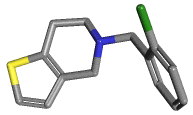|
TICLOPIDINE |
| Synonyms. Ticlopidine; 5-((2-Chlorophenyl)methyl)-4,5,6,7-tetrahydrothieno(3,2-c)pyridine; 4,5,6,7-Tetrahydro-5-((2-chlorophenyl)methyl)thieno(3,2-c)pyridine; Ticlopidina; Ticlopidinum; 5-(o-Chlorobenzyl)-4,5,6,7-tetrahydrothieno(3,2-c)pyridine; |
|
|
| PRODUCT IDENTIFICATION | |
|
CAS RN |
55142-85-3 (net), 53885-35-1 (HCl) |
|
EINECS RN |
259-498-5 (net), 258-837-4 (HCl) |
|
FORMULA |
C14H14ClNS |
|
MOLE WEIGHT |
263.79 |
|
H.S CODE |
2934.99.3000 |
|
SMILES |
c12c(CCN(C1)Cc1c(cccc1)Cl)scc2 |
|
CLASSIFICATION |
Fibrinolytic, Hematologic, Purinergic, Antithrombotic |
|
EXTRA NOTES |
Ticlopidine is an effective inhibitor of platelet aggregation. The drug has been found to significantly reduce infarction size in acute myocardial infarcts and is an effective antithrombotic agent in arteriovenous fistulas, aorto-coronary bypass grafts, ischemic heart disease, venous thrombosis, and arteriosclerosis. [MeSH] |
|
|
| PHYSICAL AND CHEMICAL PROPERTIES | |
|
PHYSICAL STATE. |
white to off-white crystalline powder |
|
MELTING POINT |
190 C |
|
BOILING POINT |
|
|
DENSITY |
|
|
SOLUBILITY IN WATER |
|
| SOLVENT SOLUBILITY |
Soluble |
|
VAPOR DENSITY |
Soluble in methanol, chloroform, insoluble in ether |
|
log P(octanol-water) |
|
|
VAPOR PRESSURE |
|
|
AUTOIGNITION TEMP |
|
| pK |
|
|
REFRACTIVE INDEX |
|
|
FLASH POINT |
|
|
|
| STABILITY AND REACTIVITY | |
| STABILITY | Stable under normal conditions. |
|
INCOMPATIBLE MATERIALS |
Strong oxidizing agents. |
| POLYMERIZATION |
Has not been reported |
|
NFPA RATINGS |
Health: 1, Flammability: 0, Reactivity: 0 |
|
|
| EXTERNAL LINKS & GENERAL DESCRIPTION |
|
USA.gov - Ticlopidine Wikipedia Linking - Ticlopidine Google Scholar Search - Ticlopidine U.S. National Library of Medicine - Ticlopidine PubChem Compound Summary - Ticlopidine IPCS INCHEM - Ticlopidine Drug Bank - Ticlopidine KEGG (Kyoto Encyclopedia of Genes and Genomes) - Ticlopidine ChEBI (http://www.ebi.ac.uk/chebi/) - Ticlopidine NCBI (http://www.ncbi.nlm.nih.gov/) - Ticlopidine ATC code B01AC05 |
|
|
| SALES SPECIFICATION | |
|
APPEARANCE |
white to off-white crystalline powder |
|
ASSAY |
98% min |
|
MELTING POINT |
190 C |
|
LOSS ON DRYING |
1.0% max |
|
HEAVY METALS |
10ppm max |
|
|
| TRANSPORT & REGULATORY INFORMATION | |
|
UN NO. |
|
| HAZARD CLASS |
|
| PACKING GROUP | |
|
|
| SAFETY INFORMATION | |
|
HAZARD OVERVIEW |
GHS (Globally Harmonised System) Classification: Acute toxicity (Oral). Hazard statements: Harmful if swallowed. Potential health effects: Eyes - May cause eye irritation. Skin - Harmful if absorbed through skin. May cause skin irritation. Ingestion - Harmful if swallowed. Inhalation - May be harmful if inhaled. May cause respiratory tract irritation. |
| SIGNAL WORD | Warning |
|
PICTOGRAMS |
|
|
HAZARD STATEMENTS |
H302 |
|
P STATEMENTS |
P264-P270-P301 + P312-P330-P501 |
| EC DIRECTIVES |
|
| HAZARD CODES |
|
|
RISK PHRASES |
22 |
|
SAFETY PHRASES |
36 |
|
|
| PACKING |
|
Preserved in light-resistant and well-closed bottles |
|
|
| PRICE INFORMATION |
|
|

